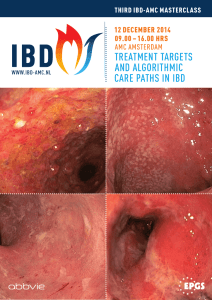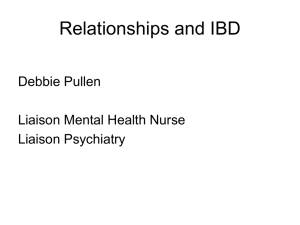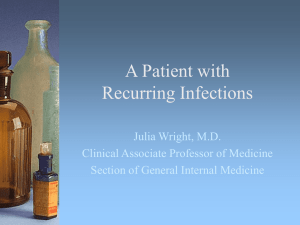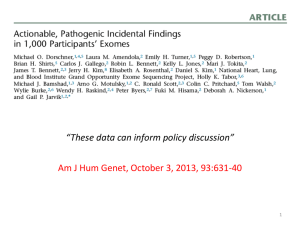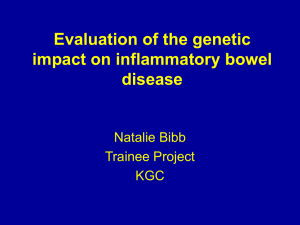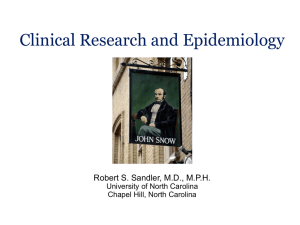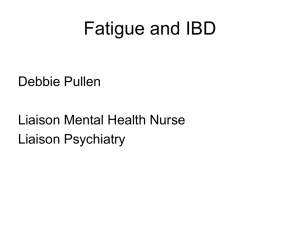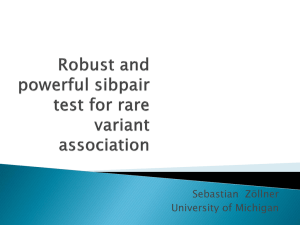Genomics and VEO-IBD - Advances in Inflammatory Bowel Diseases
advertisement
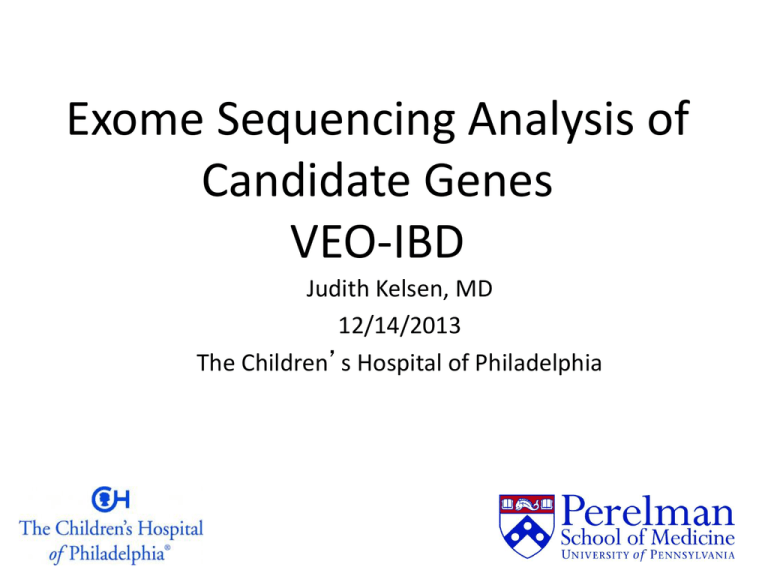
Exome Sequencing Analysis of Candidate Genes VEO-IBD Judith Kelsen, MD 12/14/2013 The Children’s Hospital of Philadelphia Objectives • Introduction to very early onset IBD • Pathogenesis of VEO-IBD • Rationale for targeted genomic approach in VEO-IBD • WES: workflow and outcomes • Future Plans Very Early-Onset IBD: The Challenge • Diagnosed ≤5 years of age • Frequently different phenotype and more severe disease presentation • Often unresponsive to conventional therapy • No standard guidelines on evaluation and treatment IBD Susceptibility Adapted from Inflamm Bowel Dis 2010:16;152 Genomics and VEO-IBD • GWAS approach – Primarily included adults and children>10 – Frequently misses rare variants, MAF <5% • Role of primary immunodeficiency • Are we missing important pathways in this cohort? Whole Exome Sequencing • Exons: – Short functionally important DNA sequences – Regions of DNA translated into protein and the untranslated region flanking them • Protein coding regions85% of disease-causing mutations Hypothesis • Rare or novel variants are enriched in patients with severe VEO-IBD – Includes genes associated with primary immunodeficiencies – Variants may contribute to the development of disease Methods Subjects: Patients with IBD ≤5 and parents Controls: 1000 Genomes Project, CHOP cohort >400 DNA extracted from whole blood Exome capture: Agilent SureSelect V4 Sequencing: Illumina HiSeq platform at an average coverage depth of 100X Alignment to human genome GRCh37 followed by post processing and variant calling Variant filter: MAF <5% Variants likely to alter protein function, (i.e missense and loss of function mutations) were kept for subsequent analysis Primary focus of analysis was on known IBD risk loci and genes associated with primary immunodeficiences and related pathways (>870 genes) Sequencing Work Flow Alignment NovoAlign (GRCh37) BAM Postprocessing GATK/Picard Variant Calling GATK Annotation SnpEff/Ensembl Custom Analysis De novo Gene Burden Compound Het Autosomal Recessive Autosomal Dominant Sample Filter Cases •1 – 175,414 var •2 – 229,750 var Annotation/Filter MAF filter (1kg, EVS) Cases •1 – 2,125 var •2 – 2,241 var Filter 3 Gene list Cases •1 – 43,493 var •2 – 60,962 var Filter 2 Non-Synonomous or High/Medium Impact Cases •1 – 130 var •2 – 150 var Results • Cohort: 44 samples • Probands: 28 (ages 8 weeks-4 yrs, 21 <2 years old) • Parents: 16 (trios: 8) • IBD risk loci and genes associated with primary immunodeficiency • 14,060 coding exons totaling more than 2.5 Mbp • 87.7% of coding exons were fully covered at more than 20x Identified Rare Variants in Candidate Genes Chr Position dbSNP ID Ref Alt DNA Alteration Gene Immunodeficiency 1 6 16 4 16 1 114699 31727677 28950051 151793903 50745926 183532364 rs114666761 Novel rs43763945 rs72719663 rs2066844 rs35012521 C G G A C T G C A G T A p.T43R p.S554T p.r514h p. T1724V p. R702W p.N419I 16 11 3293880 117869853 rs11466045 rs143538561 A C G T p.1591T p.R412W TNFRSF18 MSH5 CD19 LRBA NOD2 NCF2 CYBA MEFV IL10RA 19 17945695 17953949 rs5577834 rs3213409 C G T C p.v7221 JAK3 CVID CVID CVID CVID IBD risk loci CGD CGD FMF IL-10R (see IL10) Primary immunodeficiency; Multiple immunodeficiency pathways Variants of Immunodeficiency Pathways: Case 1 • Male, presented with diarrhea, folliculitis and FTT as infant • Diagnosed at 6 months with ileocolonic CD, refractory to medical therapy • Immunology evaluation: unremarkable • Non-synonymous variant: rare heterozygous IL-10RA variant (rs143538561; c.1234C>T, p.R412W) Case 1: IL-10R Pathway • IL-10 blunts excessive immune response • Secreted by wide variety of cells and inhibits the secretion of proinflammatory cytokines • Receptor IL10R has two subunits: – Alpha (A / 1)- required for IL10 – Beta (B / 2) -Required for IL10, IL‐22, IL‐26 • Acts through JAK1, TYK2, and STAT3 (all identified in IBD GWAS) • Defects in IL10R A/B and IL10 have been identified Variants of Immunodeficiency Pathways: Case 2 • Female presented as infant: diarrhea, anemia • Required transfusion and ICU • Diagnosed with gastric, colonic VEOIBD • NCF2: rare missense variant (rs35012521; c.1256A>T, p.N419I) was detected in heterozygosity • DHR: Dihydrorhodamine flow showed abnormal burst • Mother, with same variant, newly diagnosed with CD Case 2: NADPH Oxidase pathway • Chronic Granulomatous disease (CGD) – Genetic immunodeficiency defects in NADPH oxidase complex genes – Phagocytes are unable to kill certain bacteria and fungi as a result of reduced production of superoxide and hydrogen peroxide reactive oxygen species (ROS) • NCF2: Component of the NADPH complex Future Studies • Functional analysis is ongoing • Further variants are being analyzed and these involve other primary immunodeficiency pathways • Larger cohort project utilizing WES is underway Conclusions • Candidate causative mutations in VEO-IBD can be identified by exome sequencing • Likely some patients harbor mutations in several genes in the same or different pathways • Additional causative variants may occur in genes not previously associated with IBD • • • • • • • • • • Thank You Marcella Devoto Robert Baldassano Gary Wu Jim Lewis Mahdi Sarmady Ariella Sasson Petar Mamula David Piccoli Lindsey Albenberg Christopher Moran • • • • • Wei Liu Hakon Hakonarson Helen Pauly-Hubbard Andrew Grossman Kernika Gupta

